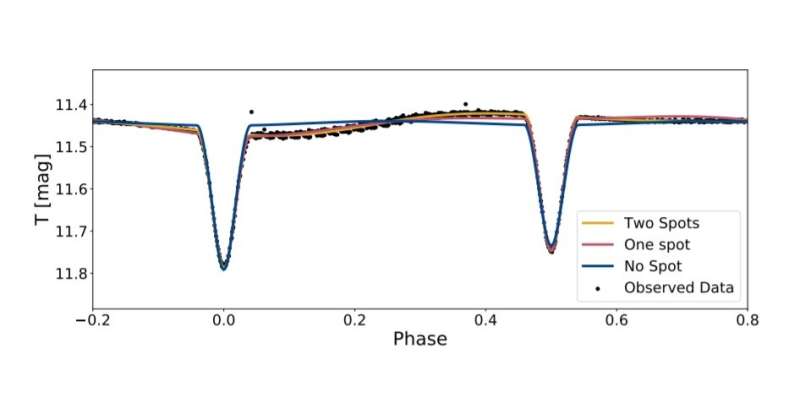TESS light curve for 2M0646 (black dots) overlaid by multiple ellc models computed using maximum likelihood stellar and orbital parameters with differing amounts of star spots. Credit: Miller et al., 2021.
Astronomers have investigated orbital and stellar parameters of an eclipsing binary known as 2M06464003+0109157. Results of the study shed more light on the nature of this peculiar system. The findings were presented in a paper published March 18 on the arXiv pre-print repository.
So far, the majority of binaries have been detected by Doppler shifts in their spectral lines; thus, these systems are called spectroscopic binaries. Observations show that in some spectroscopic binaries, spectral lines from both stars are visible, and these lines are alternately double and single. These systems are known as double-lined spectroscopic binaries (SB2).
Of special interest are detached, double-lined, eclipsing spectroscopic binaries that are crucial for astronomers testing stellar models. This is due to the fact that the masses and radii of both stars can be directly measured from the light and radial velocity curves of the system.
So a team of astronomers led by Annaliese Miller of the Western Washington University in Bellingham, Washington, took a closer look at 2M06464003+0109157—a 10 billion-year-old detached binary some 326 light years away, with a relatively high proper motion at a level of 120 km/s. Miller's team analyzed datasets from the All-Sky Automated Survey for Supernovae (ASAS-SN), the Apache Point Observatory Galactic Evolution Experiment (APOGEE) and from NASA's Transiting Exoplanet Survey Satellite (TESS) in order to get more insights into the properties of this system.
"In this pilot study we characterize the properties of one system in particular, 2M06464003+0109157, hereafter 2M0646," the astronomers wrote in the paper.
The results show that 2M0646 is a detached double-lined eclipsing binary with orbital period of approximately 1.065 days. Both components of the system have nearly equal masses—0.571 solar masses for the primary star, 0.565 solar masses for the secondary star. They are also comparable in size as the primary has a radius of 0.659 solar radii and its companion—0.57 solar radii. The orbital eccentricity for the system was found to be about 0.016.
The data indicate the presence of two star spots in the system, most likely one in every component. The spots have sizes of about 35 degrees and brightness factor of approximately 0.7. Further photometric monitoring of 2M0646 is necessary to diagnose the temperature contrast and exact location of these spots.
"Spectrophotometric monitoring of the system would provide even more information: a detailed map not only of the location and magnetic properties of the spots, but also an opportunity to perform detailed spectral fitting to test for compositional differences," the researchers explained.
The derived parameters suggest that the primary star of 2M0646 is inflated, however the cause of this inflation is still uncertain. The astronomers assume that magnetic activity or starspots are the most plausible explanations for its larger radius.
More information: Orbital and stellar parameters for 2M06464003+0109157: a double-lined eclipsing binary of spotted, sub-solar twins, arXiv:2103.10488 [astro-ph.SR] arxiv.org/abs/2103.10488
© 2021 Science X Network
























